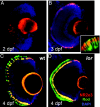Tbx2b is required for ultraviolet photoreceptor cell specification during zebrafish retinal development
- PMID: 19179291
- PMCID: PMC2632714
- DOI: 10.1073/pnas.0809439106
Tbx2b is required for ultraviolet photoreceptor cell specification during zebrafish retinal development
Abstract
The vertebrate rod and cone photoreceptors are highly specialized sensory neurons that transduce light into the chemical and electrical signals of the nervous system. Although the physiological properties of cones and rods are well known, only a handful of genes have been identified that regulate the specification of photoreceptor subtypes. Taking advantage of the mosaic organization of photoreceptors in zebrafish, we report the isolation of a mutation resulting in a unique change in photoreceptor cell fate. Mutation of the lots-of-rods (lor) locus results in a near one-for-one transformation of UV-cone precursors into rods. The transformed cells exhibit morphological characteristics and a gene-expression pattern typical of rods, but differentiate in a temporal and spatial pattern consistent with UV-cone development. In mutant larvae and adults, the highly ordered photoreceptor mosaic is maintained and degeneration is not observed, suggesting that lor functions after the specification of the other photoreceptor subtypes. In genetic chimeras, lor functions cell-autonomously in the specification of photoreceptor cell fate. Linkage analysis and genetic-complementation testing indicate that lor is an allele of tbx2b/fby (from beyond). fby was identified by a pineal complex phenotype, and carries a nonsense mutation in the T-box domain of the tbx2b transcription factor. Homozygous fby mutant larvae and lor/fby transheterozygotes also display the lots-of-rods phenotype. Based upon these data, we propose a previously undescribed function for tbx2b in photoreceptor cell precursors, to promote the UV cone fate by repressing the rod differentiation pathway.
Conflict of interest statement
The authors declare no conflict of interest.
Figures






References
-
- Freund CL, et al. Cone-rod dystrophy due to mutations in a novel photoreceptor-specific homeobox gene (CRX) essential for maintenance of the photoreceptor. Cell. 1997;91:543–553. - PubMed
-
- Furukawa T, Morrow EM, Cepko CL. Crx, a novel otx-like homeobox gene, shows photoreceptor-specific expression and regulates photoreceptor differentiation. Cell. 1997;91:531–541. - PubMed
-
- Nishida A, et al. Otx2 homeobox gene controls retinal photoreceptor cell fate and pineal gland development. Nat Neurosci. 2003;6:1255–1263. - PubMed
-
- Mears AJ, et al. Nrl is required for rod photoreceptor development. Nat Genet. 2001;29:447–452. - PubMed
Publication types
MeSH terms
Substances
Grants and funding
LinkOut - more resources
Full Text Sources
Other Literature Sources
Molecular Biology Databases

